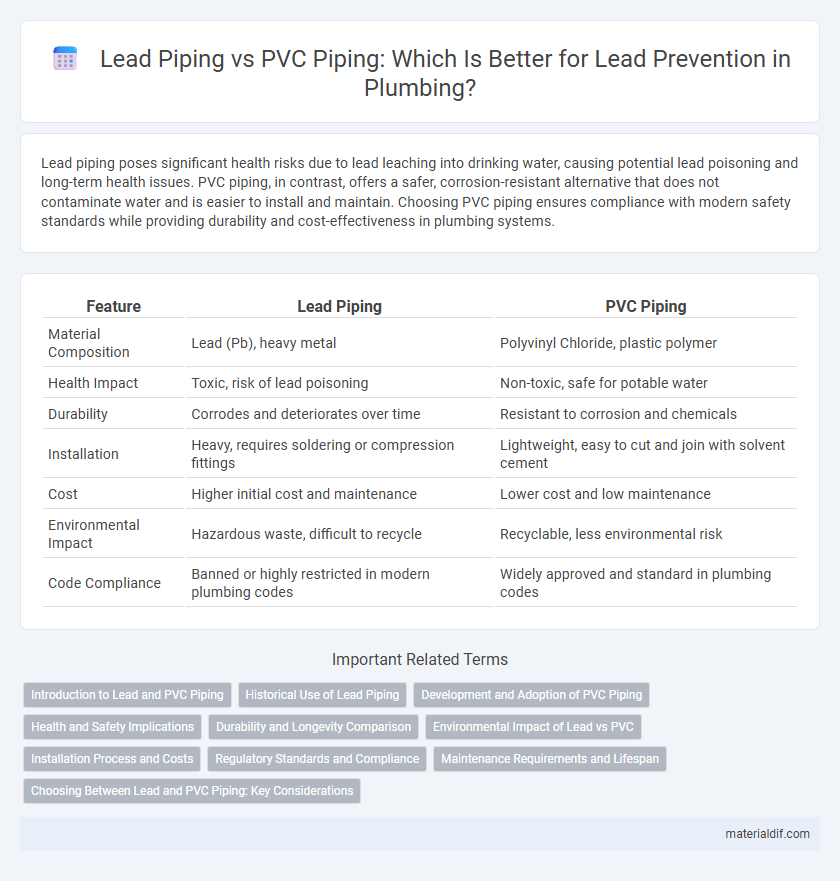Lead piping poses significant health risks due to lead leaching into drinking water, causing potential lead poisoning and long-term health issues. PVC piping, in contrast, offers a safer, corrosion-resistant alternative that does not contaminate water and is easier to install and maintain. Choosing PVC piping ensures compliance with modern safety standards while providing durability and cost-effectiveness in plumbing systems.
Table of Comparison
| Feature | Lead Piping | PVC Piping |
|---|---|---|
| Material Composition | Lead (Pb), heavy metal | Polyvinyl Chloride, plastic polymer |
| Health Impact | Toxic, risk of lead poisoning | Non-toxic, safe for potable water |
| Durability | Corrodes and deteriorates over time | Resistant to corrosion and chemicals |
| Installation | Heavy, requires soldering or compression fittings | Lightweight, easy to cut and join with solvent cement |
| Cost | Higher initial cost and maintenance | Lower cost and low maintenance |
| Environmental Impact | Hazardous waste, difficult to recycle | Recyclable, less environmental risk |
| Code Compliance | Banned or highly restricted in modern plumbing codes | Widely approved and standard in plumbing codes |
Introduction to Lead and PVC Piping
Lead piping, historically used for water supply due to its malleability and resistance to corrosion, poses significant health risks because of lead leaching into drinking water. PVC piping, made from polyvinyl chloride, offers a lightweight, corrosion-resistant, and cost-effective alternative widely adopted in modern plumbing systems. Understanding the properties and health implications of both materials is crucial for safe and efficient water distribution infrastructure.
Historical Use of Lead Piping
Lead piping was extensively used in ancient Roman aqueducts and plumbing systems due to its malleability and durability, with many structures still partially intact today. The widespread use continued into the early 20th century before health concerns about lead poisoning prompted a shift towards safer materials like PVC. Modern plumbing standards now prioritize PVC piping for its chemical resistance, cost-effectiveness, and absence of toxic contaminants.
Development and Adoption of PVC Piping
PVC piping, developed in the 1920s and widely adopted by the 1950s, became a preferred alternative to lead piping due to its durability, corrosion resistance, and cost-effectiveness. Unlike lead pipes, PVC does not pose health risks related to lead contamination, leading to stricter regulations and bans on lead piping in many countries. The broad adoption of PVC piping in residential, commercial, and industrial plumbing systems significantly reduced public health hazards and improved water quality standards worldwide.
Health and Safety Implications
Lead piping poses significant health risks due to lead leaching into drinking water, causing neurological damage and developmental issues, especially in children. PVC piping offers a safer alternative by eliminating toxic contaminants, reducing the risk of waterborne illnesses and harmful chemical exposure. Choosing PVC over lead pipes significantly improves water quality and protects public health.
Durability and Longevity Comparison
Lead piping offers exceptional durability with a lifespan often exceeding 100 years due to its resistance to corrosion and flexibility under pressure. PVC piping, while less durable in extreme temperature conditions, typically lasts 50 to 70 years and is highly resistant to chemical degradation and rust. The choice between lead and PVC should consider environmental exposure, expected usage, and health safety standards, with PVC favored for modern plumbing due to its non-toxicity and lower maintenance.
Environmental Impact of Lead vs PVC
Lead piping poses significant environmental risks due to its toxicity and potential to leach harmful lead particles into soil and water systems, leading to long-term contamination and health hazards. PVC piping, while considered less toxic, presents environmental concerns related to its production and disposal, releasing harmful dioxins and contributing to plastic pollution. Both materials impact ecosystems, but lead's persistent heavy metal contamination is more detrimental to environmental and public health.
Installation Process and Costs
Lead piping installation demands specialized labor and adherence to strict safety regulations due to its toxicity, resulting in higher labor costs and longer installation time. PVC piping offers a simpler, faster installation process with lower labor costs, as it is lightweight, easy to handle, and requires fewer specialized tools. Material costs for PVC are generally lower than lead, making PVC piping the more cost-effective option for most plumbing projects.
Regulatory Standards and Compliance
Lead piping is restricted under regulatory standards such as the Safe Drinking Water Act (SDWA) due to its toxicity and risk of lead leaching, with compliance mandates enforcing lead-free materials in potable water systems. PVC piping complies widely with EPA and NSF International standards, offering a safer, corrosion-resistant alternative approved for potable water distribution. Regulatory agencies require regular testing and certification to confirm that all plumbing materials, including PVC, meet health and safety criteria to prevent contamination.
Maintenance Requirements and Lifespan
Lead piping requires frequent maintenance due to its susceptibility to corrosion and potential health hazards from lead leaching, necessitating regular inspection and replacement. PVC piping offers low maintenance needs because of its resistance to corrosion, chemical degradation, and scaling, leading to fewer repairs or replacements over time. Typically, lead pipes have a lifespan of around 50 years, whereas PVC pipes can last over 100 years under optimal conditions.
Choosing Between Lead and PVC Piping: Key Considerations
Choosing between lead and PVC piping requires evaluating safety, durability, and cost factors. Lead pipes pose significant health risks due to lead leaching, making PVC a safer alternative widely used in modern plumbing systems. PVC piping offers corrosion resistance, ease of installation, and lower maintenance expenses, positioning it as the preferred choice for residential and commercial water supply.
Lead piping vs PVC piping Infographic

 materialdif.com
materialdif.com